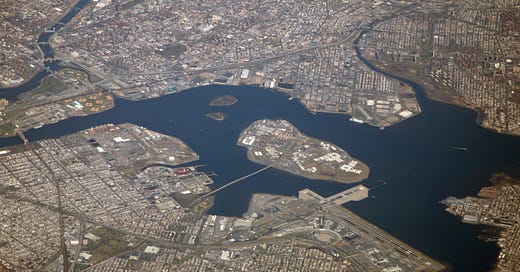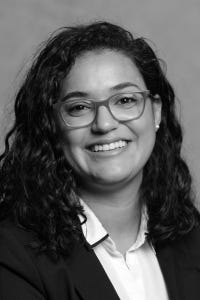Discourses: A New York Public Defender Working to #FreeThemAll
America's jails have sky-high COVID-19 infection rates and ICE is still rounding up and detaining immigrants. Here's how to help.
Catherine Gonzalez is a senior staff attorney at Brooklyn Defender Services. Gonzalez is what public defenders call a “Padilla” lawyer, after the landmark 2010 case that mandated lawyers advise their clients on how criminal cases could impact their immigration status. As coronavirus swept through New York City and ravaged the captive population at Rikers Island, Gonzalez and her colleague struggled to fight through a shut-down court system to free as many people as possible. As of May 8, the day Gonzalez and I spoke, there were still 3,884 inmates in jail at Rikers. The coronavirus infection rate is 9.53 percent at the facility.
Rikers is an extreme case, but all over the country, public defenders are facing the same battle as Gonzalez. She walked me through the messy, half-functioning court system and the most pressing needs of incarcerated people during the coronavirus pandemic—as well as what the rest of us can do to help.
Tell me what your job has been like for the past couple of months. When did you start focusing on getting as many clients out as possible?
For us, incarcerated clients have always been at the center—trying to figure out what we could do for them. I personally have a lot of clients who are over 50 with underlying conditions. There are thousands of people trapped in close quarters—for us, specifically at Rikers Island, but also in all these jails and prisons in the country, and people being held in immigration detention, which is a large quantity. Those people have no way distancing themselves, no ability to take any basic protections. They kind of rely on the carceral system that they’re in to protect them.
The last normal day in the courts was March 13. After that, the courts began to slowly change. We began to really focus on clients that we had determined to be high risk, based on the advice we were getting from medical professionals very, very early on, and focusing on ways to get them out, which became really difficult because the governor [of New York, Andrew Cuomo] started passing and implementing executive orders that impacted the procedures of the court. And the courts essentially completely shut down.
How do you communicate with your clients and how do court proceedings work now?
It’s been really hard to do our job, even basic things, for the past month and a half or so. Everything has been changing week to week. At the very beginning [of court systems shutting down], we really had no way of communicating with our clients—there was a point where the only way that we could speak with our clients, in mid-March, was literally writing a letter, putting that letter in the mail, and then hoping and waiting by the phone for the client to call. That became really, really distressing. Luckily, then they started implementing video conferencing, allowing us to directly video conference with our clients from our homes—before, we had to physically go to the court and to a room designated for video conferencing. But the calls, depending on the facility, are still very backed up—there are still clients that we don’t have access to at all, besides them calling or writing to us.
I’m what we call in my field a “Padilla lawyer”—my job is to advise clients on the impact that their criminal case could have on their immigration status. But I don’t have the opportunity to meet clients [when they’re first assigned a public defender], so if our client is sent to the jail then I have additional obstacles. I try to find a way to communicate with them as quickly as possible after arraignment, to try to give them the advice that applies in their situation, which can sometimes mean you’re at imminent risk of being picked up by ICE. I don’t have numbers for April yet, but ICE was still conducting arrests in the middle of this pandemic. My opinion is that they were taking advantage of people trying to practice social distancing and self-quarantining, because they were sure that people would be home, so they would go to people’s homes to conduct arrests.
What is keeping the majority of your clients incarcerated during this process? What is it that’s keeping them from being released and being able to stay safe with their families while their case is pending?
The majority of the population [at Rikers] are people that we refer to as being pretrial detainees. So people who are solely in because they are unable to afford bail, whether it’s a few hundred dollars or a few thousand dollars.
What is the quickest action the governor or the mayor could take to alleviate this risk for your clients?
The easy answer is release everybody. Obviously it’s a little bit more technical than that. There are people who are serving sentences, those people could be granted some sort of clemency. For people who are pretrial detainees, changing the form of bail so that it’s not monetary—finding a way for someone to be out while they’re fighting their case so they could be in safety, because we know what the conditions are at Rikers and in other jails, there’s no way our clients can be safe in that environment.
The mayor did authorize the release of a bunch of people from Rikers—mostly people with low-level offenses. I can see the mayor or the state making an argument that the people who didn’t qualify for that were people who had quote-unquote violent offenses. The problem with that is in New York we have offenses that are classified as violent where the actual allegations don’t involve any violence at all. Our criminal legal system has this really, really important doctrine called the presumption of innocence, right?
We can see that the population at Rikers has been drastically reduced—not just during the pandemic, but since January 1st when the new bail laws were implemented. There’s a lot that has been done, but we think that more needs to be done because there’s a lot of people who are still there, and there’s still people going in, because there’s still arrests going on.
What are you hearing right now from clients about the conditions inside Rikers? What are their needs in terms of support from the outside?
The biggest thing is masks, or protective equipment. Our understanding right now is that for the most part, people at Rikers aren’t being provided masks. If they are given a mask, they’re told “you’re getting this one mask and it needs to last you for several weeks.” We understand that there’s a policy that the staff should have masks to give to people, but that’s really not happening for people—I think it depends on the facility, but that’s my understanding for clients.
What can an everyday citizen do to help you do your job and help incarcerated people?
There’s so much that they can do. In New York, people can donate to bail funds: There are two bail funds. One is an emergency bond out for people in immigration detention. That's being run by the Brooklyn Bail Fund. There’s also a COVID Bailout fund and the Emergency Release Fund—they’re taking donations and they are posting bail for people who are indigent and can’t post bail. People can contact local officials and the governor to demand decarceration; [you] can visit the Cuomo Let Them Go website for steps to take action. There’s also a fund that our office started called Todos Together that’s directly to help immigrant families for people we have been able to get out of immigration detention. As you know, a lot of immigrant families are not able to access the benefits and the programs that have been put in place to help New Yorkers and the rest of the nation deal with the devastating impact of this pandemic.
What are your hopes for the future of the legal system—could there be any positive changes that come out of this crisis?
This situation has only served to highlight just the issues that we have been screaming and yelling about—with jails and with biased policing. The reliance on detention and incarceration is just not the way to go. Right now, it means that we’re putting people at risk of death. A lot of people have pending criminal charges and have no idea when they can resolve it. This notion of “having their day in court” has definitely been put on hold. My biggest hope is that we really can take this time, and some of the changes that have been implemented [in the courts], and focusing on the humanity of the people who have been coming before the criminal legal system.
For a very long time, and definitely during this administration, the criminal legal system has served really as a pipeline for immigration detention. Incarceration there is not at all really necessary. This past Wednesday, Carlos Escobar-Mejia—who was an individual in ICE detention in California—passed away from complications due to the virus. That’s the first confirmed death. We’ve been ringing alarm bells about how dangerous the conditions are in immigration custody. We’ve been filing a lot of writs and lawsuits in federal courts to urge the courts to release people, and we have been winning some of those. But there’s so so much more work to be done.
Image via Flickr/Doc Searles
This blog is part of our interview series, Discourses. To read all of our interviews, click here.







